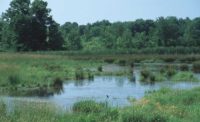Revised Rule on Navigable Waters Takes Effect in 49 States

A new navigable waters rule, which determines which bodies of water are subject to federal regulation, went into effect June 22.
Photo courtesy of the U.S. Fish and Wildlife Service.
The Trump Administration’s new navigable waters rule, which significantly curtails the types of water bodies subject to federal jurisdiction, went into effect in all states but Colorado on June 22 after a federal judge in California rejected an attempt by a group of 17 state attorneys general to temporarily block the rule.
The regulation replaces the Obama-era Waters of the U.S. rule that was contentious among contractors and construction groups because it could have led to the Army Corps of Engineers regulating some temporary streams created after rains or snow, such as roadside ditches.
Retired Col. John W. Eisenhauer, commander of the Corps’ Portland District from 2011 to 2013 and now a senior advisor at the water consultancy group Dawson and Associates, expects stakeholders with permits under the previous regulation may seek a revised permit under the new regulations because “under the old rule they have a lot of onerous mitigation,” he told ENR.
Eisenhauer also says the Corps, along with the US Environmental Protection Agency, may issue guidance for the rule.
The Corps is currently working to train its staff on implementation of the rule, Corps spokesman Doug Garman said in an email. "We are reviewing all Regulatory Guidance Letters and will update any we deem necessary." The last regulatory guidance letter on jurisdictional determinations was issued in October 2016, he added.
Individual districts, however, have leeway in interpreting the rule based on past decisions and court precedents, Eisenhauer says.
In his June 19 order, U.S. District Court Judge Richard Seeborg in San Francisco denied a request from 17 state attorneys general, the District of Columbia, the City of New York and the North Carolina Dept. of Environmental Quality denying a nationwide preliminary injunction. In his decision, he said the request for an injunction failed because the states didn’t show how allowing the rule to take effect would cause irreparable harm.
But also on June 19, a U.S. District Court judge in Colorado halted implementation of the rule in that state, agreeing that its case against the rule had merit. The rule will be on hold in Colorado until the case goes to trial or is dismissed.
Separate lawsuits against the regulation have been filed by other groups around the country.
The National Association of Home Builders, which intervened in favor of the new rule in both cases, said in a blog post that on June 19 it and other industry trade associations met virtually with EPA and Corps officials. "The discussion covered issues such as how to distinguish an excluded ephemeral feature from a jurisdictional intermittent feature, identify adjacent wetlands, and apply the new definition of 'uplands' that applies to features lacking all three wetland factors (i.e., plants, soils, hydrology)," according to the post.
The Associated General Contractors of America says it has invited EPA and the Corps to provide further updates to members at upcoming events. “We are supportive of the rule and we look forward to working with the agencies as they implement the rule to help ensure consistency throughout the EPA regions and Corps districts,” Brian Turmail, group spokesman, said in an emailed statement.
The American Association of State Highway and Transportation Officials said that in multiple comment letters sent to the EPA and the Army Corps dating back to 2011, it has consistently advocated for a change in the jurisdictional status of water resources under the old rule. "This rule change provides state DOTs with a clearer, simpler standard that will allow them to avoid the unnecessary costs and maintenance work delays associated with the old rule," said AASHTO spokesman Tony Dorsey. He said AASHTO remains neutral on other aspects of the proposed rule and several individual state DOTs have prepared comments related to other aspects of the rule.



